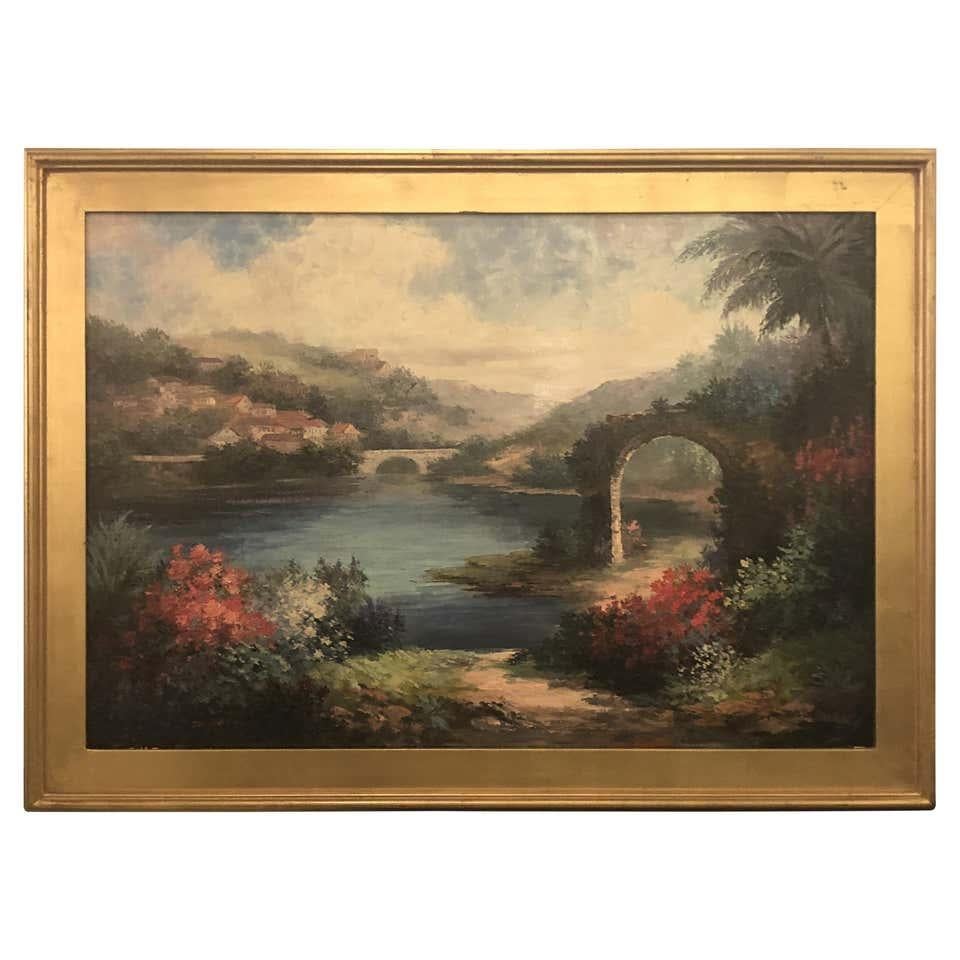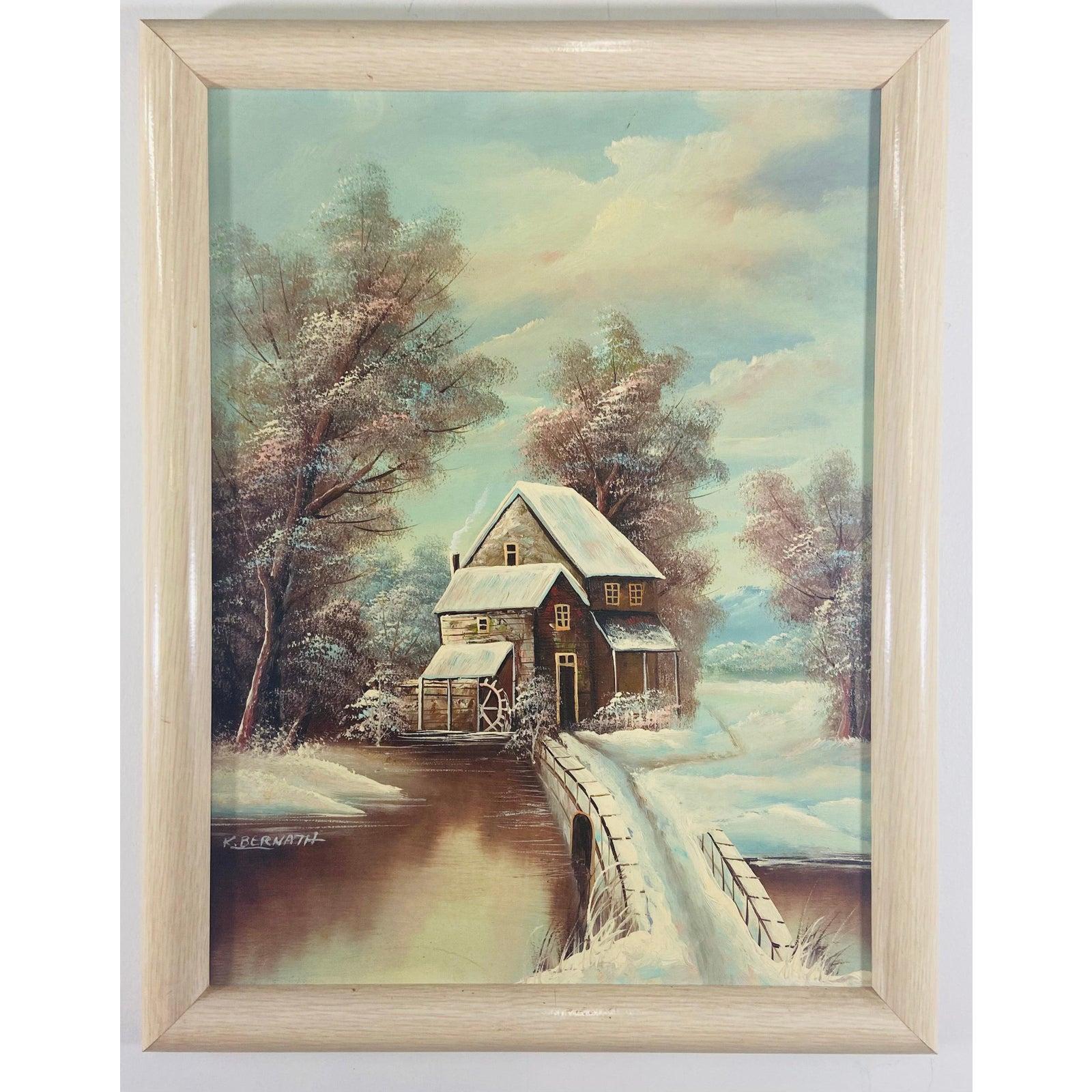Items Similar to "Boats at Dock, Montauk" Nicolai Cikovsky, Long Island Fishing
Want more images or videos?
Request additional images or videos from the seller
1 of 10
Nicolai Cikovsky"Boats at Dock, Montauk" Nicolai Cikovsky, Long Island Fishing
About the Item
Nicolai Cikovsky
Boats at Dock, Montauk
Signed lower right
Oil on canvasboard
20 x 24 inches
The well known and highly regarded landscape and figure painter Nicolai S. Cikovsky was born in Russia in 1894. He studied at the Vilna Art School, 1910-1914; the Penza Royal Art School, 1914-1918; and Moscow High Tech Art Institute, 1921-1923. Thus he came of age during a period of momentous cultural, political, and social upheaval.
In the aftermath of the civil war, he left Russia and emigrated to the United States in 1923, exhibiting in that year in New York City at the Charles Daniels Gallery and, in the early 1930s, the Downtown Gallery and the Whitney Museum of American Art. In 1942, Cikovsky began spending summers on Long Island, New York, in the North Sea area, where he moved permanently in the late 1970s.
Best known for his plein air landscapes of bucolic Hampton Bays, NY and figurative works, Cikovsky was lauded for his ability to infuse his art with feeling, capturing the spirit of a place. In Long Island he was one of the Hampton Bay Group of artists.The informally noted leader of the group was dramatic and acclaimed Blaue Reiter,Futurist- Expressionist fellow Russian artist David D. Burliuk. Emigre artists who would later be involved in the group came to America around the same time but under different circumstances. Burliuk and Cikovsky left an unhospitable Bolshevik Russia following Worl War II , arriving here in 1922 & 1923, respectively. The Soyer twins, Moses and Raphael, arrived as youngsters in 1912, fleeing Tsarist anti-Jewish persecution. John Graham (b. Ivan Dombrovski) and Arshile Gorky (formerly Vosdanig Adoian) arrived in 1920 in search of a place to make a living as artists. George Constant arrived from Greece in 1910 seeking an art education. Once in New York, these artists sought out places to exhibit their work. Ultimately, the downtown Manhattan gallery scene united them with many other artists emigre artists.
Cikovsky was a member of New York City institutions, including the National Academy of Design (Associate 1968; Academician 1970); National Institute of Arts and Letters; and Society of Painters, Sculptors, and Cikovsky’s works were exhibited & won prizes in the most important exhibitions of the day, including the Brooklyn Museum's 1926 International Exhibition of Modern Art, the National Academy of Design & Art Institute of Chicago annuals, and at the NY World’s Fair. Other exhibitions included MOMA & the Whitney Museum of American Art, NYC, the Pennsylvania Academy of the Fine Arts, and the Carnegie Institute.
- Creator:Nicolai Cikovsky (1894-1987, American, Russian)
- Dimensions:Height: 26 in (66.04 cm)Width: 30 in (76.2 cm)
- Medium:
- Movement & Style:
- Period:
- Condition:
- Gallery Location:New York, NY
- Reference Number:1stDibs: LU1841213713902
About the Seller
5.0
Platinum Seller
These expertly vetted sellers are 1stDibs' most experienced sellers and are rated highest by our customers.
Established in 2021
1stDibs seller since 2022
59 sales on 1stDibs
Typical response time: 1 hour
- ShippingRetrieving quote...Ships From: New York, NY
- Return PolicyA return for this item may be initiated within 3 days of delivery.
More From This SellerView All
- "Pueblo Indians, Taos, New Mexico, " Georgia Klitgaard, Southwest LandscapeBy Georgina KlitgaardLocated in New York, NYGeorgina Klitgaard Pueblo Indians, Taos, New Mexico Signed lower right Oil on canvas 18 x 24 inches Georgina Berrian was born in Spuyten Duyvil, New York in 1893. She was educated a...Category
Mid-20th Century Modern Landscape Paintings
MaterialsCanvas, Oil
- "Tree, Trunk, and Roots, New York" Joseph Stella, American ModernismBy Joseph StellaLocated in New York, NYJoseph Stella (1877 - 1946) Tree, Trunk, and Roots, Bronx, New York, circa 1924 Oil on canvas 12 x 16 inches inscribed in another hand Joseph Stella/Estate and bears Joseph Stella Estate stamp (on the reverse) Provenance: The Estate of the Artist Rabin & Kreuger, New Jersey Parke Bernet Galleries, New York, March 14, 1968, Lot 147 ACA Galleries, New York Thence by descent Stella was born June 13, 1877 at Muro Lucano, Italy, a mountain village not far from Naples. He became painter laureate of Muro Lucano when he was in his teens with a representation of the local saint in the village church. Stella immigrated to America in 1896 and studied medicine and pharmacology, but upon the advice of artist friend Carlo de Fornaro, who recognized his undeveloped talent, he enrolled at the Art Students League in 1897. Stella objected to the rule forbidding the painting of flowers, an indication of his lifelong devotion to flower painting. He also studied under William Merritt Chase in the New York School of Art and at Shinnecock Hills, Long Island in 1901-1902, displaying the bravura brushwork and dark Impressionist influence of Chase. Stella liked to paint the raw street life of immigrant society, rendering this element more emotionally than the city realists, the Aschcan School headed by Robert Henri. Stella went through a progression of styles--from realism to abstraction--mixing media and painting simultaneously in different manners, reviving styles and subjects years later. The "Survey" sent Stella to illustrate the mining disaster of 1907 in Monongah, West Virginia, and in 1908 commissioned him to execute drawings of the Pittsburgh industrial scene. Steel and electricity became a major experience in shaping his responses to the modern world, and Stella succeeded in portraying the pathos of the steelworkers and the Pittsburgh landscape. Stella went abroad in 1909 at the age of thirty-two, lonely for his native land. He returned to Italy, traveling to Venice, Florence and Rome. He took up the glazing technique of the old Venetian masters to get warmth, transparency, and depth of color. One of Stella's paintings was shown in the International Exhibition in Rome in 1910 and was acquired by the city of Rome. The influence of the French Modernists awakened his dormant individuality. His friendship with Antonio Mancini, a Futurist, also played a role in his new style. At the urging of Walter Pach...Category
1920s American Modern Landscape Paintings
MaterialsCanvas, Oil
- "New York City Harbor, " Modernist View of Port and Boats on a Cloudy DayBy Bela de TirefortLocated in New York, NYBela De Tirefort (1894 - 1993) New York City Harbor, 1932 Oil on canvasboard 14 x 18 Signed and dated lower left: De Tirefort 32 Bela de Tirefort was born in Eastern Europe, painted...Category
1930s American Modern Landscape Paintings
MaterialsCanvas, Oil, Board
- "Manhattan Looking East, " Herman Rose, WPA New York City View from MidtownBy Herman RoseLocated in New York, NYHerman Rose (1909 - 2007) Manhattan Looking East (View from Midtown), 1952-54 Oil on canvas 26 x 28 inches Signed lower right Fairfield Porter wrote an essay in ArtNews on this exact painting in 1955. Please inquire for a copy of the article. Literature: Fairfield Porter, "Herman Rose Paints a Picture," ArtNews, April 1955 Volume 54, Number 2, illustrated. Herman Rose was best known for his depictions of cityscapes of New York City. Herman Rappaport was born in Brooklyn, New York. in 1909. Herman Rose was the professional pseudonym of Herman Rappaport. Originally trained as a draftsman and studied at the National Academy of Design from 1927 to 1929, he was later employed by the Works Progress Administration's Murals Division under Arshile Gorky from 1934 until 1939. In 1939, after experimenting with a variety of contemporary expressionistic styles, Rose decided to paint from life. Working mostly in East New York and East Canarsie in Brooklyn, and in Manhattan, Rose began to paint roof tops and street scenes. Rappaport began using the name Herman Rose when he held his first solo art exhibition in 1946 at the Charles Egan Gallery in New York City. Although he initially began as an Expressionistic painter, he became known for small, light-filled Impressionist paintings of still life, cityscapes and skies by the early 1950s. His paintings and images were often composed of very small dabs of paint and tiny, blurry "squares," which combined to create the image on canvas, his favorite medium. Often described as a "lyrical painter" Rose's work "interpreted traditional subjects: landscape, still life and the figure like the Post-Impressionists from whom he developed his own style, Rose built up forms from distinct touches of color that don't entirely blend in the viewer's eye. This gives his surfaces an active quality that flattens forms, one of the great lessons of modernism." Herman Rose's work received official recognition when Ms. Dorothy Miller of Museum of Modern Art (MoMA) included his work in an exhibition called, "15 Americans," alongside work by Clyfford Still, Mark Rothko and Jackson Pollock. New York Times art critic Hilton Kramer wrote of Rose's work in 1981, "{he} must surely be counted among the most beautiful works anyone has produced in this challenging medium for many years." The Art in America art critic Lawrence Campbell...Category
1950s American Modern Landscape Paintings
MaterialsCanvas, Oil
- "New York Harbor View, " Leon Dolice, Cityscape Skyline from the RiverBy Leon DoliceLocated in New York, NYLeon Dolice View from New York Harbor, circa 1960 Signed lower left Oil on canvas 26 x 44 inches Provenance: Private Collection, Boston Private Collection, Worcester, Massachusetts Leon Dolice was one of the masters of the New York City street scene in the decades between the world wars. He showed an unquenchable fascination with the built urban environment and combined it with an interest in modernist technique and a knowledge of European art. His work helped to redefine realist painting and remains a brooding tribute and memorial to the New York of the 1920s and 1930s. Dolice was born in Vienna, Austria in 1892, the son of a machinist. As a young man, he worked as an illustrator and stage designer and traveled the capital cities of Europe, studying the works of the ‘old masters.’ At age 28, Dolice immigrated to New York City and moved to Greenwich Village, then in its first Bohemian incarnation. Dolice developed a friendship with George Luks and became proficient at the art of copperplate etching. Dolice owned an art gallery and studio in his home on Third Avenue and 32nd street where he sold his depictions of the city. One of his favorite subjects was the Third Avenue El, directly adjacent to this studio, but he also traveled the eastern coast, painting urban scenes in Washington D.C., Baltimore, and Philadelphia. Dolice’s New York City etchings...Category
1960s Modern Landscape Paintings
MaterialsCanvas, Oil
- "The Belt Parkway, " Lawrence Rothbort, Brooklyn, Cars, Textured ImpastoBy Lawrence RothbortLocated in New York, NYLawrence Rothbort Belt Parkway, circa 1950 Oil on canvas 48 x 48 inches Lawrence Rothbort was born March 1920 in Brooklyn, New York. He was a model from infancy for his father, Amer...Category
1950s Modern Landscape Paintings
MaterialsOil, Canvas
You May Also Like
- The Yacht KITSKAD Off Catalina IslandBy J. Duncan GleasonLocated in Costa Mesa, CADuncan Gleason lived in New York and other places for work or studies but it was really Southern California where he felt most at home, and looking at his body of work, that love of ...Category
1950s Modern Paintings
MaterialsCanvas, Oil, Board
- Vintage Impressionist Oil on Canvas Painting, SignedLocated in Plainview, NYAn elegant vintage impressionist oil on canvas painting signed by artist Tasica -1977. The painting features a street scene in the...Category
Late 20th Century Modern Landscape Paintings
MaterialsCanvas, Oil
- Americana Landscape Oil on Canvas Painting Signed P. Paul, FramedLocated in Plainview, NYAn elegant oil on canvas landscape painting featuring a lake view in a paradisiac environment. The painting is finely framed in custom giltwood frame. A wonderful addition to any liv...Category
1980s American Modern Landscape Paintings
MaterialsOil, Canvas
- K. Bernath Outdoor Snow Scene Oil on Canvas PaintingLocated in Plainview, NYA landscape snowy scene by K.Bernath. The day snowy scene depicts a house / cabin in the middle of the snowy woods with a blue sky. The painting is framed. Dimensions Framed: 17.75...Category
1970s Modern Landscape Paintings
MaterialsCanvas, Oil
- 1980's Oil on Canvas Impressionistic Beach Scene Painting, Framed & SignedLocated in Plainview, NYThis is an oil on canvas painting depicting a group of people, seaside. The gilt frame is finely hand carved. The piece is from the 1980s and is signed Dimensions: Framed 18" H, ...Category
1980s Modern Landscape Paintings
MaterialsCanvas, Oil
- Six O'ClockLocated in Los Angeles, CASix O-Clock, c. 1942, oil on canvas, 30 x 20 inches, signed and titled several times verso of frame and stretcher (perhaps by another hand), marked “Rehn” several times on frame (for the Frank K. M. Rehn Galleries in New York City, who represented Craig at the time); Exhibited: 1) 18th Biennial Exhibition of Contemporary American Oil Paintings from March 21 to May 2, 1943 at The Corcoran Gallery of Art in Washington, D.C. #87, original price $450 (per catalog) (exhibition label verso), 2) Craig’s one-man show at the Frank K. M. Rehn Galleries, New York City, from October 26 to November 14, 1942, #10 (original price listed as $350); and 3) Exhibition of thirty paintings sponsored by the Harrisburg Art Association at the State Museum of Pennsylvania in Harrisburg in March, 1944 (concerning this exhibit, Penelope Redd of The Evening News (Harrisburg, Pennsylvania) wrote: “Other paintings that have overtones of superrealism inherent in the subjects include Tom Craig’s California nocturne, ‘Six O’Clock,’ two figures moving through the twilight . . . .” March 6, 1944, p. 13); another label verso from The Museum of Art of Toledo (Ohio): original frame: Provenance includes George Stern Gallery, Los Angeles, CA About the Painting Long before Chris Burden’s iconic installation outside of the Los Angeles County Museum of Art, Urban Light, another artist, Tom Craig, made Southern California streetlights the subject of one of his early 1940s paintings. Consisting of dozens of recycled streetlights from the 1920s and 1930s forming a classical colonnade at the museum’s entrance, Burden’s Urban Light has become a symbol of Los Angeles. For Burden, the streetlights represent what constitutes an advanced society, something “safe after dark and beautiful to behold.” It seems that Craig is playing on the same theme in Six O-Clock. Although we see two hunched figures trudging along the sidewalk at the end of a long day, the real stars of this painting are the streetlights which brighten the twilight and silhouette another iconic symbol of Los Angeles, the palm trees in the distance. Mountains in the background and the distant view of a suburban neighborhood join the streetlights and palm trees as classic subject matter for a California Scene painting, but Craig gives us a twist by depicting the scene not as a sun-drenched natural expanse. Rather, Craig uses thin layers of oil paint, mimicking the watercolor technique for which he is most famous, to show us the twinkling beauty of manmade light and the safety it affords. Although Southern California is a land of natural wonders, the interventions of humanity are already everywhere in Los Angeles and as one critic noted, the resulting painting has an air of “superrealism.” About the Artist Thomas Theodore Craig was a well-known fixture in the Southern California art scene. He was born in Upland California. Craig graduated with a degree in botany from Pomona College and studied painting at Pamona and the Chouinard Art School with Stanton MacDonald-Wright and Barse Miller among others. He became close friends with fellow artist Milford Zornes...Category
1940s American Modern Landscape Paintings
MaterialsCanvas, Oil





